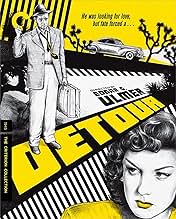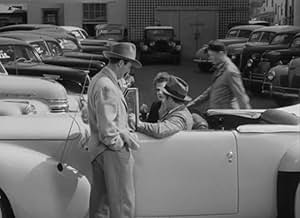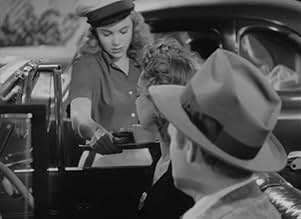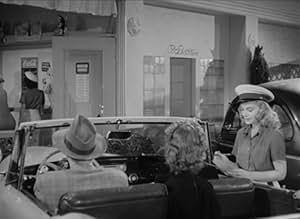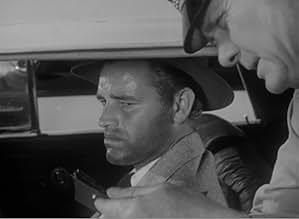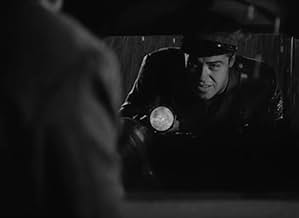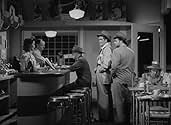CALIFICACIÓN DE IMDb
7.3/10
21 k
TU CALIFICACIÓN
El azar atrapa al autoestopista Al Roberts en una trama noir.El azar atrapa al autoestopista Al Roberts en una trama noir.El azar atrapa al autoestopista Al Roberts en una trama noir.
- Premios
- 1 premio ganado en total
Don Brodie
- Used Car Salesman
- (sin créditos)
Roger Clark
- Cop
- (sin créditos)
Eddie Hall
- Tony - Used-Car Lot Mechanic Inspecting Car
- (sin créditos)
Harry Mayo
- Nightclub Patron
- (sin créditos)
Harry Strang
- California Border Patrolman
- (sin créditos)
Opiniones destacadas
It's a tribute to Edgar Ulmer that "Detour", made for about thirty thousand dollars, still keeps an interest with new fans who discover it. According to some comments, "Detour" has not been seen in this country in quite a while, but we recall the first time we saw it when it was presented at New York's Film Forum as part of a Film Noir festival in the late eighties. The copy shown recently on TCM has a poor quality, while the print we saw at Film Forum was in better condition.
What makes "Detour" a must see, is the clever way its narrative unfolds on the screen. Al and Sue are seen first in the small bistro he plays the piano and she sings, in Manhattan. Sue sings a happy rendition of "I Can't Believe You're in Love with Me", and Al shows he can improvise on a theme by Chopin as he jazzes it up. When Sue decides to pack it and move to L.A., Tom promises he'll follow. The tragic mistake he makes is to intent crossing the country hitchhiking. Even in the forties, it's a miracle he made it alive!
In Arizona Al meets the kind Charles Haskell, who happens to be going all the way to L.A. and offers him a ride. The two men develop an easy friendship until the point when Haskell dies of an apparent heart attack. Al disposes of the body and keeps going, assuming now, Haskell's persona. At the nearest gas station he sees a pretty woman, Vera, who appears is hitchhiking, and offers her a ride. This will prove to be his biggest mistake.
Vera turned out to be Al's worst nightmare. She knows Al is not Haskell since she, herself, knows the man. Al ends up a virtual prisoner hiding in the apartment they have rented in Hollywood. He can't escape. When Vera realizes there's a lot of money to be made by having Al pretend to impersonate the dead Haskell, he refuses. She threatens to call the police and he is left on the other room pulling the telephone cord...
The film works because all the elements are in place in this satisfying 67 minutes work and because of the great performances Mr. Ulmer got out of Tom Neal and Ann Savage. Edmund MacDonald and Claudia Drake played Haskell and Sue.
"Detour" was shot in two sets and it shows. It's a small film that doesn't pretend what it's not, and that's basically why audiences seem to like it as it's discovered.
What makes "Detour" a must see, is the clever way its narrative unfolds on the screen. Al and Sue are seen first in the small bistro he plays the piano and she sings, in Manhattan. Sue sings a happy rendition of "I Can't Believe You're in Love with Me", and Al shows he can improvise on a theme by Chopin as he jazzes it up. When Sue decides to pack it and move to L.A., Tom promises he'll follow. The tragic mistake he makes is to intent crossing the country hitchhiking. Even in the forties, it's a miracle he made it alive!
In Arizona Al meets the kind Charles Haskell, who happens to be going all the way to L.A. and offers him a ride. The two men develop an easy friendship until the point when Haskell dies of an apparent heart attack. Al disposes of the body and keeps going, assuming now, Haskell's persona. At the nearest gas station he sees a pretty woman, Vera, who appears is hitchhiking, and offers her a ride. This will prove to be his biggest mistake.
Vera turned out to be Al's worst nightmare. She knows Al is not Haskell since she, herself, knows the man. Al ends up a virtual prisoner hiding in the apartment they have rented in Hollywood. He can't escape. When Vera realizes there's a lot of money to be made by having Al pretend to impersonate the dead Haskell, he refuses. She threatens to call the police and he is left on the other room pulling the telephone cord...
The film works because all the elements are in place in this satisfying 67 minutes work and because of the great performances Mr. Ulmer got out of Tom Neal and Ann Savage. Edmund MacDonald and Claudia Drake played Haskell and Sue.
"Detour" was shot in two sets and it shows. It's a small film that doesn't pretend what it's not, and that's basically why audiences seem to like it as it's discovered.
I'm not as fond of DETOUR as some of the other reviewers on here, purely because I found it an entirely depressing viewing experience. It's one of the darkest film noirs out there, leaden with a dreadful atmosphere throughout, full of foreboding, darkness, and misery. And I guess those are the reasons why it's so well remembered.
The film is directed by THE BLACK CAT director Edgar G. Ulmer in much the same way he would direct one of his horror pictures. Tom Neal makes for a rather unlikeable hero, trying desperate to hitch-hike from one end of the country to the other and coming unstuck when he falls in with a seemingly friendly driver. He takes a chance and thinks he's made it when in fact he's just about to meet Ann Savage's Vera.
Savage is the stand-out feature of this film and I hated every element of her angry, vengeful, selfish character. She's the worst femme fatale I've ever seen, a noxious character utterly devoid of redeeming features, to the degree that I found the movie hard to watch whenever she was around (which is most of the time). I admit that I thought the climax was excellent given what's come previously, although the only thing I came away from this feeling was relief, relief that it was over.
The film is directed by THE BLACK CAT director Edgar G. Ulmer in much the same way he would direct one of his horror pictures. Tom Neal makes for a rather unlikeable hero, trying desperate to hitch-hike from one end of the country to the other and coming unstuck when he falls in with a seemingly friendly driver. He takes a chance and thinks he's made it when in fact he's just about to meet Ann Savage's Vera.
Savage is the stand-out feature of this film and I hated every element of her angry, vengeful, selfish character. She's the worst femme fatale I've ever seen, a noxious character utterly devoid of redeeming features, to the degree that I found the movie hard to watch whenever she was around (which is most of the time). I admit that I thought the climax was excellent given what's come previously, although the only thing I came away from this feeling was relief, relief that it was over.
Dear Me, PRC, the sub-Republic/Monogram indie studio that was considered the most cardboard of studios managed on this occasion to actually create a deliciously nasty noir. DETOUR, as many commentators here like to spoil for you by telling you THE WHOLE STORY is an excellent low budget film of one man's descent into accidental crime. So powerful are the screen images and the seedy tawdry drama that one almost forgets they are watching one of the cheapest (and profitable) films ever made. Monogram Pictures made several highly appreciated low end noirs (like the truly shocking DECOY of 1946) and must have been very envious of the now enduring $66,000 PRC masterpiece DETOUR. In fact I would not be surprised to find that Monogram were inspired enough to make DECOY as a result. Tom Neal sadly actually went to jail in real life in a genuine DETOUR like way and vicious Ann Savage lived up to her name in a few more noir shockers for various crummy B/W outfits who specialized until the mid 50s in similar films. NARROW MARGIN and KISS ME DEADLY are equals. DETOUR is one of the most rewarding grim descents into 40s desperation film making and the doomed loser played by Tom Neal certainly is the most tragic of them all. This is a great film. It is all it is meant to be and viewers who sit riveted to the unfolding emotional horror are genuinely rewarded. Originally TIFFANY STUDIOS in the 20s the lot became for hire after 1932 then was the home for GRAND NATIONAL from 1935 -39 and morphed into PRC in 1940. With a huge shed of snazzy 20s furniture and sets from the previous 15 years it allowed PRC's budget conscious front office to upgrade their art direction by virtue of all these classy fittings costumes bought and left there by the sophisticated view of those previous managements. I have seen a number of independent B grade30s pix made there with the same sets and outfittings inbetween management reincarnation. PRC in the late 40s were bought up by EAGLE-LION a US/Brit franchise headed by J Arthur Rank and rolled in 1950 into UNITED ARTISTS. As one journalist aptly wrote "No other poverty row outfit were able to cash in their chips so handsomely". Good on 'em! See DETOUR and gasp!!
This is one of the all-time great examples of film noir. It can practically be used to define the genre: shadowy black and white cinematography; a star-crossed protagonist ("...fate sticks out a leg to trip you."); a femme fatale (the unforgettable Ann Savage as Vera); cynical voice-over narration; ambiguous morality. All these elements are brought together magnificently by director Edgar G. Ulmer, who incredibly made this movie in several days on a shoestring budget. His direction is so masterful that the low budget sets only add to the film. This is a great masterpiece and one of the marvels in film history.
8dxia
One recurrent thought passes through my mind as I watch "Detour." It is that I do not believe a single moment of its story-telling. It isn't because of the incredible coincidences or the bitter irony but because of the simple goodness of the main character. Characters in film noir are not role models or good people placed into bad circumstances. They are bad people who believe that they're good.
The characters in "Double Indemnity," "Body Heat," or "The Talented Mr. Ripley" do not think of themselves as bad people. They believe they are forced into their crimes by the world, which is the essential difference between crime movies and noir. As pointed out by Roger Ebert: "the bad guys in crime movies know they're bad and want to be, while a noir hero thinks he's a good guy who has been ambushed by life."
"Detour" is told through the central character, Al Roberts, who recalls his story as one made through impossible coincidences and horrible luck. But there is something not right about his story. The audience can pick out the incongruities and flaws as soon as they're told. Was Charles Haskell's death really the result of bad luck or simply a murderer trying to convince himself that it was? We wonder if it is possible that a person as innocent as Al says he is can be forced into such immoral activities. However, the explanation is quite clear. Al is retelling the story not as a true confession but as a man reviewing his defense to the police.
Watching the movie, I was reminded of Tanazaki's "The Key," a novel in which the main character deliberately lies to the audience as a way of reaching the story's conclusion. We do not see a real conclusion to "Detour," but we sense that the police will find the same flaws in Al's story as we do. And that is not a fatal form of story-telling but a way of looking into the mind of a true noir character and seeing the darker depths of his soul. That is why film noir is so haunting and why this movie is so definitive in its genre.
The characters in "Double Indemnity," "Body Heat," or "The Talented Mr. Ripley" do not think of themselves as bad people. They believe they are forced into their crimes by the world, which is the essential difference between crime movies and noir. As pointed out by Roger Ebert: "the bad guys in crime movies know they're bad and want to be, while a noir hero thinks he's a good guy who has been ambushed by life."
"Detour" is told through the central character, Al Roberts, who recalls his story as one made through impossible coincidences and horrible luck. But there is something not right about his story. The audience can pick out the incongruities and flaws as soon as they're told. Was Charles Haskell's death really the result of bad luck or simply a murderer trying to convince himself that it was? We wonder if it is possible that a person as innocent as Al says he is can be forced into such immoral activities. However, the explanation is quite clear. Al is retelling the story not as a true confession but as a man reviewing his defense to the police.
Watching the movie, I was reminded of Tanazaki's "The Key," a novel in which the main character deliberately lies to the audience as a way of reaching the story's conclusion. We do not see a real conclusion to "Detour," but we sense that the police will find the same flaws in Al's story as we do. And that is not a fatal form of story-telling but a way of looking into the mind of a true noir character and seeing the darker depths of his soul. That is why film noir is so haunting and why this movie is so definitive in its genre.
¿Sabías que…?
- TriviaWhile the crew was setting up to film a hitchhiking scene, a passing car tried to pick up Ann Savage (made up to look dirty and disheveled), causing the crew to break out laughing.
- ErroresIn the first shots of Al hitchhiking, the film is reversed. The cars are driving on the wrong side of the highway and the drivers sitting behind the wheel are sitting on the right side of their vehicles.
- Citas
Al Roberts: Money. You know what that is, the stuff you never have enough of. Little green things with George Washington's picture that men slave for, commit crimes for, die for. It's the stuff that has caused more trouble in the world than anything else we ever invented, simply because there's too little of it.
- ConexionesEdited into Esto es todo (2009)
- Bandas sonorasI Can't Believe That You're in Love with Me
(uncredited)
Written by Jimmy McHugh and Clarence Gaskill
Performed by Claudia Drake
Played often in the score
Selecciones populares
Inicia sesión para calificar y agrega a la lista de videos para obtener recomendaciones personalizadas
Detalles
- Fecha de lanzamiento
- País de origen
- Sitios oficiales
- Idioma
- También se conoce como
- Detour
- Locaciones de filmación
- 9263 Sierra Highway, Actis, California, Estados Unidos(Vera hitchhiking at Richfield gas station called Actis Service Station)
- Productora
- Ver más créditos de la compañía en IMDbPro
Taquilla
- Presupuesto
- USD 30,000 (estimado)
- Total en EE. UU. y Canadá
- USD 16,172
- Fin de semana de estreno en EE. UU. y Canadá
- USD 5,127
- 2 dic 2018
- Total a nivel mundial
- USD 16,172
- Tiempo de ejecución1 hora 6 minutos
- Color
- Relación de aspecto
- 1.37 : 1
Contribuir a esta página
Sugiere una edición o agrega el contenido que falta

Principales brechas de datos
What is the French language plot outline for Peligros del destino (1945)?
Responda
![Ver Trailer [OV]](https://m.media-amazon.com/images/M/MV5BZGEyYTUwNDQtN2ZjZi00YmY2LWE2ZjUtOTY3NjQ3NDQ0Zjg3XkEyXkFqcGdeQXRyYW5zY29kZS13b3JrZmxvdw@@._V1_QL75_UX500_CR0)
